Triacontagon
| Regular triacontagon | |
|---|---|
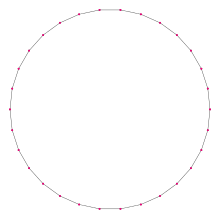 A regular triacontagon | |
| Type | Regular polygon |
| Edgesandvertices | 30 |
| Schläfli symbol | {30}, t{15} |
| Coxeter–Dynkin diagrams | |
| Symmetry group | Dihedral(D30), order 2×30 |
| Internal angle(degrees) | 168° |
| Properties | Convex,cyclic,equilateral,isogonal,isotoxal |
| Dual polygon | Self |
Ingeometry,atriacontagonor 30-gon is a thirty-sidedpolygon.The sum of any triacontagon's interior angles is5040degrees.
Regular triacontagon
[edit]Theregulartriacontagonis aconstructible polygon,by an edge-bisectionof a regularpentadecagon,and can also be constructed as atruncatedpentadecagon,t{15}. Atruncatedtriacontagon, t{30}, is ahexacontagon,{60}.
One interior angle in aregulartriacontagon is 168 degrees, meaning that one exterior angle would be 12°. The triacontagon is the largest regular polygon whose interior angle is the sum of theinterior anglesof smallerpolygons:168° is the sum of the interior angles of theequilateral triangle(60°) and theregular pentagon(108°).
Theareaof a regular triacontagon is (witht= edge length)[1]
Theinradiusof a regular triacontagon is
Thecircumradiusof a regular triacontagon is
Construction
[edit]
As 30 = 2 × 3 × 5, a regular triacontagon isconstructibleusing acompass and straightedge.[2]
Symmetry
[edit]
Theregular triacontagonhas Dih30dihedral symmetry,order 60, represented by 30 lines of reflection. Dih30has 7 dihedral subgroups: Dih15,(Dih10,Dih5), (Dih6,Dih3), and (Dih2,Dih1). It also has eight morecyclicsymmetries as subgroups: (Z30,Z15), (Z10,Z5), (Z6,Z3), and (Z2,Z1), with Znrepresenting π/nradian rotational symmetry.
John Conwaylabels these lower symmetries with a letter and order of the symmetry follows the letter.[3]He givesd(diagonal) with mirror lines through vertices,pwith mirror lines through edges (perpendicular),iwith mirror lines through both vertices and edges, andgfor rotational symmetry.a1labels no symmetry.
These lower symmetries allows degrees of freedoms in defining irregular triacontagons. Only theg30subgroup has no degrees of freedom but can be seen asdirected edges.
Dissection
[edit]
Coxeterstates that everyzonogon(a 2m-gon whose opposite sides are parallel and of equal length) can be dissected intom(m-1)/2 parallelograms.[4] In particular this is true for regular polygons with evenly many sides, in which case the parallelograms are all rhombi. For theregular triacontagon,m=15, it can be divided into 105: 7 sets of 15 rhombs. This decomposition is based on aPetrie polygonprojection of a15-cube.
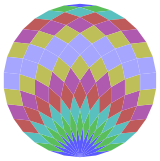
|
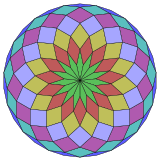
|
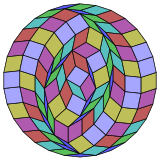
|

|
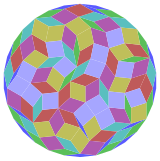
|
Triacontagram
[edit]A triacontagram is a 30-sidedstar polygon(though the word is extremely rare). There are 3 regular forms given bySchläfli symbols{30/7}, {30/11}, and {30/13}, and 11 compound star figures with the samevertex configuration.
| Compounds and stars | |||||||
|---|---|---|---|---|---|---|---|
| Form | Compounds | Star polygon | Compound | ||||
| Picture | 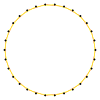 {30/2}=2{15} |
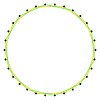 {30/3}=3{10} |
 {30/4}=2{15/2} |
 {30/5}=5{6} |
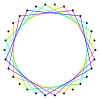 {30/6}=6{5} |
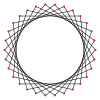 {30/7} |
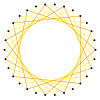 {30/8}=2{15/4} |
| Interior angle | 156° | 144° | 132° | 120° | 108° | 96° | 84° |
| Form | Compounds | Star polygon | Compound | Star polygon | Compounds | ||
| Picture | 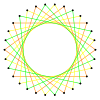 {30/9}=3{10/3} |
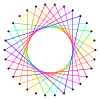 {30/10}=10{3} |
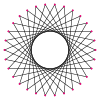 {30/11} |
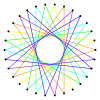 {30/12}=6{5/2} |
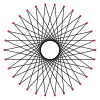 {30/13} |
 {30/14}=2{15/7} |
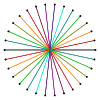 {30/15}=15{2} |
| Interior angle | 72° | 60° | 48° | 36° | 24° | 12° | 0° |
There are alsoisogonaltriacontagrams constructed as deeper truncations of the regularpentadecagon{15} and pentadecagram {15/7}, and inverted pentadecagrams {15/11}, and {15/13}. Other truncations form double coverings: t{15/14}={30/14}=2{15/7}, t{15/8}={30/8}=2{15/4}, t{15/4}={30/4}=2{15/4}, and t{15/2}={30/2}=2{15}.[5]
| Compounds and stars | |||||||||||
|---|---|---|---|---|---|---|---|---|---|---|---|
| Quasiregular | Isogonal | Quasiregular Double coverings | |||||||||
 t{15} = {30} |

|

|

|

|

|

|

|
 t{15/14}=2{15/7} | |||
 t{15/7}={30/7} |

|

|

|

|

|

|

|
 t{15/8}=2{15/4} | |||
 t{15/11}={30/11} |

|

|

|

|

|

|

|
 t{15/4}=2{15/2} | |||
 t{15/13}={30/13} |

|

|

|

|

|

|

|
 t{15/2}=2{15} | |||
Petrie polygons
[edit]The regular triacontagon is thePetrie polygonfor three 8-dimensional polytopes with E8symmetry, shown inorthogonal projectionsin the E8Coxeter plane.It is also the Petrie polygon for two 4-dimensional polytopes, shown in the H4Coxeter plane.
| E8 | H4 | |||
|---|---|---|---|---|
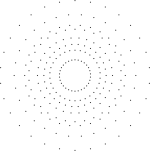 421 |
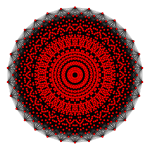 241 |
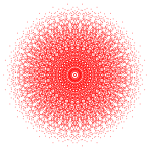 142 |
 120-cell |
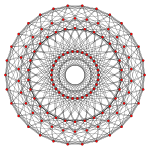 600-cell |
The regular triacontagram {30/7} is also the Petrie polygon for thegreat grand stellated 120-cellandgrand 600-cell.
References
[edit]- ^Weisstein, Eric W."Triacontagon".MathWorld.
- ^Constructible Polygon
- ^The Symmetries of Things,Chapter 20
- ^Coxeter,Mathematical recreations and Essays, Thirteenth edition, p.141
- ^The Lighter Side of Mathematics: Proceedings of the Eugène Strens Memorial Conference on Recreational Mathematics and its History, (1994),Metamorphoses of polygons,Branko Grünbaum



